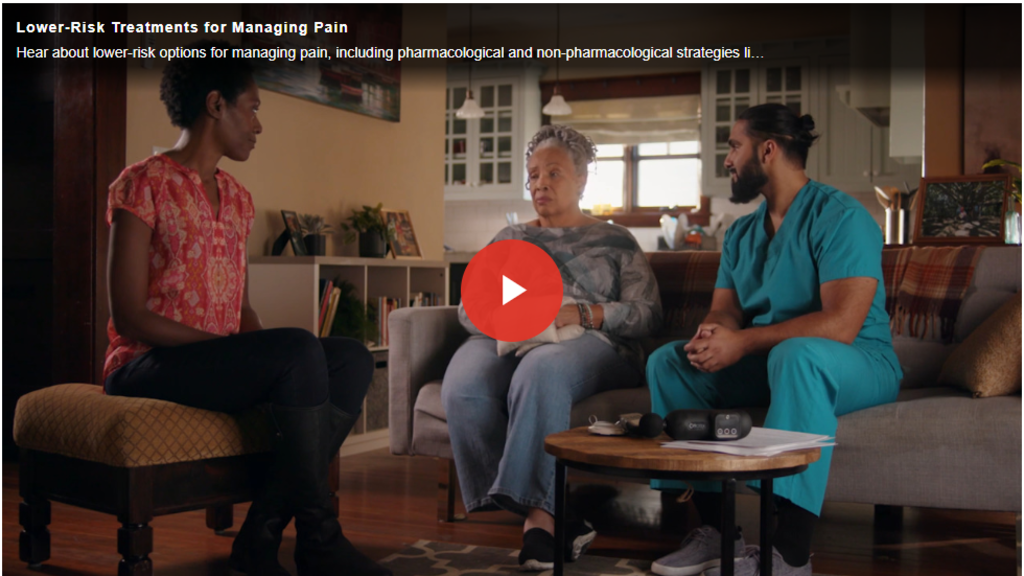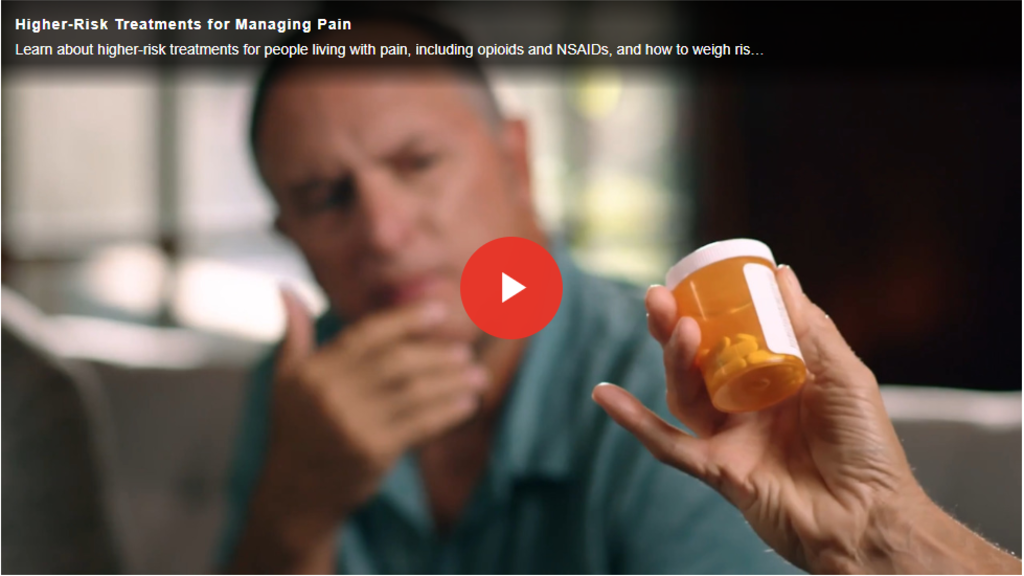
Pain Management Information
The information in this section provides individuals with knowledge in the form of “Fast Facts” (documents that provide a brief overview and details about a specific subject) that review topics such as An Overview of Nondrug Pain and Symptom Management; specific non-drug pain management techniques; Safety Precautions for Opioid Use; Opioid Side Effects and Bowel Management for Opioid Use.
*New Video Resources*

Lower-Risk Treatments for Managing Pain
There is a range of lower-risk approaches for pain management, including pharmacological and non-pharmacological strategies. Hear about options for family caregivers and persons in pain to consider, including non-opioid analgesics and sleep hygiene, physical activity, meditation/guided imagery, and heat and cold as alternatives.

Higher-Risk Treatments for Managing Pain
Hear about higher-risk treatments for people living with pain, such as opioids and NSAIDs. The goals of the person in pain and the benefits and risks of medication are important considerations. Explore side effects and safety issues and get guidance in decision making and securing medications safely.
The videos are housed on the AARP website and were developed in partnership with Home Alone Alliance and Betty Moore Family Caregiving Institute.
Low-Risk Pain Treatments, Benefits/Risks, and Tips
Information, including benefits/risks and tips, on behavioral therapies, restorative therapies, complementary alternatives/integrative therapies, and low-risk medications.
Higher-Risk Pain Treatments: Benefits, Risks, and Tips
Information on higher-risk pain treatments, including summary of risks, use and monitoring tips, and the benefits of common drugs.

Non-Drug Related Interventions
Nondrug Pain and Symptom Management
- “Nondrug Pain and Symptom Management” provides an overview of the basics of Nondrug Pain Treatment Techniques. Shares some examples of different types of nondrug treatments, describes the general advantages and possible disadvantages and describes what an older adult can do with these types of treatments.
*NEW* Acupuncture
- "Acupuncture” provides a general overview of acupuncture and provides guidelines for its use, tips about what to expect, and other things you can do.
*NEW* BioFeedback
- “BioFeedback” provides information about key points related to biofeedback training and several pain-related conditions that can be reduced by biofeedback.
- Cold Therapy
- “Cold as a Nondrug Pain Treatment” provides a general overview of cold treatments and guidelines for its use, describes types of equipment needed, and directions on how to use this treatment.
Controlled breathing & Guided Imagery
- “Controlled Breathing & Guided Imagery as a Nondrug Pain Treatment” provides a general overview of controlled breathing and guided imagery, detailed directions on how to use these techniques.
Distraction
- “Distraction as a Nondrug Pain Treatment” provides a general overview of the use of distraction the benefits, potential problems, and methods to use.
Exercise
- “Exercise as a Nondrug Pain Treatment” provides a general overview of the use of exercise including how it works to assist with pain control, and different types of exercise one might try.
Heat Therapy
- “Heat as a Nondrug Pain Treatment” provides a general overview of the use of heat to assist with pain control including heat treatment options, application guidelines (Dos and Don’ts), equipment needed, and directions on use.
Massage
- “Massage as a Nondrug Pain Treatment” provides a general overview of the use of massage to assist with pain control including application guidelines (both Dos and Don’ts), equipment needed, and directions on use.
Music
- “Music as a Nondrug Pain Treatment” provides a general overview of the use of music to assist with pain control including tips on use, and what research suggests about the use of music.
*NEW* Physical Therapy/Occupational Therapy
- “''Physical Therapy (PT) and Occupational Therapy (OT)” highlights the difference between PT and OT and how they can help you manage pain.
Positioning
- “Positioning as a Nondrug Pain Treatment” provides a general overview of the use of positioning to assist with pain control including the benefits of positioning, and guidelines.
Relaxation
- “Relaxation as a Nondrug Pain Treatment” provides a general overview of the use of positioning to assist with pain control including the benefits of relaxation, and relaxation techniques.
*NEW* Tai chi
- ''Tai Chi" provides an overview of Thai chi (pronounced TIE-CHEE) and how it can be used to manage pain.
*NEW* Yoga
- ''Yoga is a Hindu discipline that focuses on bringing harmony between body and mind to influence health and relaxation. Yoga practiced in the United States generally focuses on physical postures, breathing techniques, and meditation.
Drug Related Interventions
Bowel Management for Opioid Use
- “Bowel Management for Opioid Use” provides information about the issue of constipation that can occur with Opioid medication use to treat pain. The document provides the caregiver with important information to be aware of related to past medical history and lists possible bowel management treatments.
Opioid Side Effects (Adverse Effects)
- “Opioid Side Effect (Adverse Effects” provides general information about Opioid pain medication side effects, including common side effects and how to address each.
Safety Precautions for Opioid Use with Older Adults
- “Safety Precautions for Opioid Use with Older Adults” provides information about key principles related to Opioid pain medication use with older adults and provides an overview of common opioid side effects (adverse effects) seen in older adults.
*NEW* Understanding the 2022 CDC Clinical Practice Guideline for Prescribing Opioids for Pain
- Clinical practice guidelines (often called “clinical guidelines”) are published statements that include recommendations on how to diagnose and/or treat a medical condition. While clinical guidelines are developed for the use of healthcare providers, they offer valuable information to patients and caregivers as well. Understanding the intent and guiding principles for implementation of these guidelines offer insight into the topics the healthcare provider should address with the patient and caregiver related to the use of opioids for pain control.
Webpage Last Revised 12.20.2023
